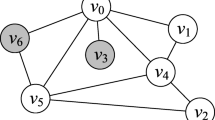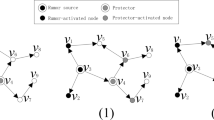Abstract
Online social networks facilitate the spread of information, while rumors can also propagate widely and fast, which may mislead some users. Therefore, suppressing the spread of rumors has become a daunting task. One of the widely used approaches is to select users in the social network to spread the truth and compete against the rumor, so that users who receive the truth before receiving rumors will not trust or propagate the rumor. However, the existing works only aim to speed up blocking rumors without considering the pertinency of users. For example, consider a social media platform operator aiming to enhance user online safety. Based on the user’s online behavior, the users who are at high risk should be alerted first. Motivated by this, we formally define the rumor blocking with pertinence set (RBP) problem, which aims to find a truth seed set that maximizes the number of nodes affected by truth and ensures that the number of influenced nodes within the pertinence set reaches at least a given threshold. To solve this problem, we design a hybrid greedy framework (HGF) algorithm with local and global phases. We prove that HGF can provide a \((1-1/e-\epsilon )\)-approximate solution with high probability while reducing the cost of the sampling process. Extensive experiments on 8 real social networks demonstrate the efficiency and effectiveness of our proposed algorithms.



















Similar content being viewed by others
Availability of data and materials
The datasets used in this paper are public available at SNAP (http://snap.stanford.edu/).
References
Borgs, C., Brautbar, M., Chayes, J., Lucier, B.: Maximizing social influence in nearly optimal time. In: SODA, pp. 946–957 (2014)
Borodin, A., Filmus, Y., Oren, J.: Threshold models for competitive influence in social networks. In: Internet and Network Economics, pp. 539–550 (2010)
Budak, C., Agrawal, D., El Abbadi, A.: Limiting the spread of misinformation in social networks. In: WWW, pp. 665–674 (2011)
Chen, C., Zhang, M., Sun, R., Wang, X., Zhu, W., Wang, X.: Locating pivotal connections: the k-truss minimization and maximization problems. World Wide Web 25(2), 899–926 (2022)
Chen, C., Zhu, Q., Sun, R., Wang, X., Wu, Y.: Edge manipulation approaches for k-core minimization: Metrics and analytics. TKDE 35(1), 390–403 (2023)
Chen, C., Zhu, Q., Wu, Y., Sun, R., Wang, X., Liu, X.: Efficient critical relationships identification in bipartite networks. World Wide Web 25(2), 741–761 (2022)
Chen, W., Lakshmanan, L.V.S., Castillo, C.: Information and Influence Propagation in Social Networks. Synthesis Lectures on Data Management. Morgan & Claypool Publishers (2013)
DSouza, K.M., French, A.M.: Fake news detection using machine learning: an adversarial collaboration approach. Int. Res. (2023)
Guo, Q., Wang, S., Wei, Z., Chen, M.: Influence maximization revisited: efficient reverse reachable set generation with bound tightened. In: SIGMOD, pp. 2167–2181 (2020)
He, Q., Zhang, D., Wang, X., Ma, L., Zhao, Y., Gao, F., Huang, M.: Graph convolutional network-based rumor blocking on social networks. TCSS 1–10 (2022)
Huang, K., Wang, S., Bevilacqua, G., Xiao, X., Lakshmanan, L.V.: Revisiting the stop-and-stare algorithms for influence maximization. VLDB 913–924 (2017)
Jiang, Z., Chen, X., Ma, J., Yu, P.S.: Rumordecay: rumor dissemination interruption for target recipients in social networks. IEEE Trans. Syst. Man Cybern. 6383–6395 (2022)
Kempe, D., Kleinberg, J., Tardos, É.: Maximizing the spread of influence through a social network. In: SIGKDD, pp. 137–146 (2003)
Khalil, E.B., Dilkina, B., Song, L.: Scalable diffusion-aware optimization of network topology. In: SIGKDD, pp. 1226–1235 (2014)
Liu, C., Zhou, X., Zehmakan, A.N., Zhang, Z.: A fast algorithm for moderating critical nodes via edge removal. IEEE Trans. Knowl. Data Eng. (2023)
Manouchehri, M.A., Helfroush, M.S., Danyali, H.: Temporal rumor blocking in online social networks: A sampling-based approach. IEEE Trans. Syst. Man Cybern. 4578–4588 (2022)
Nguyen, H.T., Thai, M.T., Dinh, T.N.: Stop-and-stare: optimal sampling algorithms for viral marketing in billion-scale networks. In: SIGMOD, pp. 695–710 (2016)
Song, C., Hsu, W., Lee, M.L.: Node immunization over infectious period. In: CIKM, pp. 831–840 (2015)
Sun, R., Chen, C., Liu, X., Xu, S., Wang, X., Lin, X.: Critical nodes identification in large networks: The inclined and detached models. World Wide Web 25(3), 1315–1341 (2022)
Sun, R., Chen, C., Wang, X., Wu, Y., Zhang, M., Liu, X.: The art of characterization in large networks: Finding the critical attributes. World Wide Web 25(2), 655–677 (2022)
Tang, J., Tang, X., Xiao, X., Yuan, J.: Online processing algorithms for influence maximization. In: SIGMOD, pp. 991–1005 (2018)
Tang, J., Tang, X., Yuan, J.: Profit maximization for viral marketing in online social networks: Algorithms and analysis. TKDE 1095–1108 (2018)
Tang, Y., Shi, Y., Xiao, X.: Influence maximization in near-linear time: a martingale approach. In: SIGMOD, pp. 1539–1554 (2015)
Tong, G., Wu, W., Du, D.Z.: Distributed rumor blocking with multiple positive cascades. TCSS 468–480 (2018)
Tong, G., Wu, W., Guo, L., Li, D., Liu, C., Liu, B., Du, D.Z.: An efficient randomized algorithm for rumor blocking in online social networks. TNSE 845–854 (2017)
Tong, H., Prakash, B.A., Eliassi-Rad, T., Faloutsos, M., Faloutsos, C.: Gelling, and melting, large graphs by edge manipulation. In: CIKM, pp. 245–254 (2012)
Tsai, J., Nguyen, T.H., Tambe, M.: Security games for controlling contagion. In: AAAI (2012)
Wang, B., Chen, G., Fu, L., Song, L., Wang, X.: Drimux: dynamic rumor influence minimization with user experience in social networks. TKDE 2168–2181 (2017)
Wang, X., Zhang, Y., Zhang, W., Lin, X.: Distance-aware influence maximization in geo-social network. In: ICDE, pp. 1–12 (2016)
Wang, X., Zhang, Y., Zhang, W., Lin, X.: Efficient distance-aware influence maximization in geo-social networks. TKDE 599–612 (2017)
Wang, X., Zhang, Y., Zhang, W., Lin, X., Chen, C.: Bring order into the samples: a novel scalable method for influence maximization. TKDE 29(2), 243–256 (2017)
Wu, H., Zhang, Z., Fang, Y., Zhang, S., Jiang, Z., Huang, J., Li, P.: Containment of rumor spread by selecting immune nodes in social networks. Math. Biosci. Eng 2614–2631 (2021)
Xie, J., Zhang, F., Wang, K., Lin, X., Zhang, W.: Minimizing the influence of misinformation via vertex blocking. In: ICDE, pp. 789–801 (2023)
Yan, R., Li, D., Wu, W., Du, D.Z., Wang, Y.: Minimizing influence of rumors by blockers on social networks: algorithms and analysis. TNSE 1067–1078 (2019)
Yang, L., Ma, Z., Li, Z., Giua, A.: Rumor containment by blocking nodes in social networks. IEEE Trans. Syst. Man Cybern. (2023)
Zhang, P., Chen, W., Sun, X., Wang, Y., Zhang, J.: Minimizing seed set selection with probabilistic coverage guarantee in a social network. In: SIGKDD, pp. 1306–1315 (2014)
Zhang, X., Wang, H., Yu, J., Chen, C., Wang, X., Zhang, W.: Polarity-based graph neural network for sign prediction in signed bipartite graphs. World Wide Web 25(2), 471–487 (2022)
Zhang, X., Wang, H., Yu, J., Chen, C., Wang, X., Zhang, W.: Bipartite graph capsule network. World Wide Web 26(1), 421–440 (2023)
Funding
This work was supported by ZJNSF LQ20F020007 and ZJNSF LY21F020012.
Author information
Authors and Affiliations
Corresponding authors
Ethics declarations
Conflicts of interest
We declare that the authors have no conflict of interest.
Additional information
Publisher's Note
Springer Nature remains neutral with regard to jurisdictional claims in published maps and institutional affiliations.
Rights and permissions
Springer Nature or its licensor (e.g. a society or other partner) holds exclusive rights to this article under a publishing agreement with the author(s) or other rightsholder(s); author self-archiving of the accepted manuscript version of this article is solely governed by the terms of such publishing agreement and applicable law.
About this article
Cite this article
Xiang, F., Wang, J., Wu, Y. et al. Rumor blocking with pertinence set in large graphs. World Wide Web 27, 6 (2024). https://doi.org/10.1007/s11280-024-01235-w
Published:
DOI: https://doi.org/10.1007/s11280-024-01235-w




